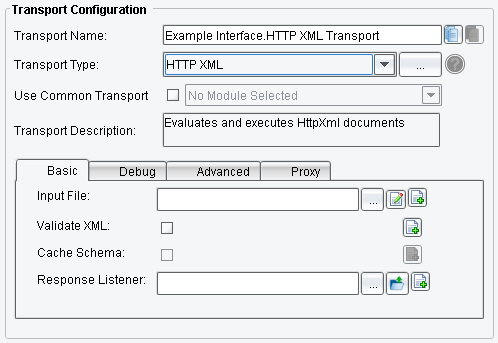HTTP XML Transport
The HTTP XML transport evaluates and executes HttpXML documents.
On the Basic tab you can specify:
Input File: input HttpXML file, if no HttpXML transaction contents are expected.
Validate XML: if the received or loaded XML document should be validated against its schema.
Cache Schema: if the schema for validation should be cached, so it won’t be re-loaded on every execution.
Response Listener: A “Programmable” Listener to receive the output of the HttpXML evaluation.
On the Debug tab you can specify:
Evaluation Logging: if selected, extra information about the evaluation process will be logged to help with debugging its execution. Keep in mind that, in some cases, sensitive information may be logged with this option, so it should be kept off by default. NOTE: This is separate from the Log elements in the XML structure.
On the Advanced tab you can specify:
Cache Type: set the type of cache used internally for storing data when the XML structure is executed.
Handle Bad Response: if selected, responses with failure status codes (ie, 404 or 500) will still be returned via the Response section in the XML, rather than failing with an exception. Please note that this means response status values should be checked prior to trying to handle their contents.
The Proxy tab allows the user to configure the proxy if necessary.
The Proxy Host and Proxy Port specify which host and port to use for the proxy.
The Proxy User and Password specify the username and password for proxy authentication.




